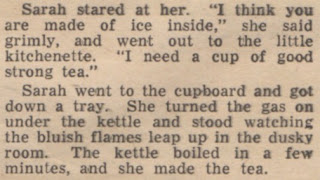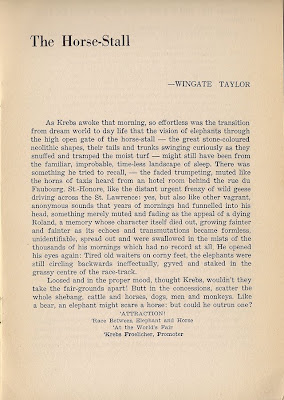No Pattern for Life
Frances Shelley Wees
The Star Weekly, 11 December 1955
Not so much novel as novella,
No Pattern for Life came and went sixty years ago this month, never to see print again. It pains me to write that this is no great loss. Frances Shelley Wees' mystery
The Keys of My Prison, ranks amongst the year's best finds. This is the most disappointing.
The
Star Weekly did its best to position
No Pattern for Life as a Christmas story – 'twas the season, after all – but the action extends well into the following spring. That said, the story does open on a Christmasy scene: Melinda Elliott, she of the deftly moving hands, decorates mistletoe with bright red ribbon.
See above.
Widowed Sarah Chalmers sits looking on, "absently knitting a white nylon sweater" and passing judgement. Roommates, the two not only share a flat but work together at a Toronto radio station. Their boss, George Johnson, is basically
Jack Kent Cooke. And because Johnson is Cooke, he has divorced Agnes, his wife of twenty years, to marry vivacious young Melinda. Sarah doesn't approve.
Good question. Johnson is a balding businessman suffering a mid-life crisis – there's nothing more to him than that. Melinda's fascination has everything to do with his wealth and the many gifts it provides. The first chapter brings a mink coat, but before Melinda can don her dead apparel she trips over Christmas presents and flies face first into the edge of an open door. The story's greatest action – decorating the mistletoe comes a close second – it leads to an operation for a detached retina. The months of convalescence that follow allow Melinda time to contemplate life and reconsider her betrothal.
Priggish busybody Sarah seeks to provide moral guidance while dodging dinner invitations from Jim Malone, Melinda's eye surgeon. Here's a coincidence: not only did Jim and his wife Kitty attend university with Sarah and her dead husband Dick, but he just happens to have grown up in the very same small town as Melinda. Courtesy of Jim, Sarah learns of her roommate's kinfolk:
"I can't imagine how she would get into your orbit. Sarah, With her father and mother, and what must have been her upbringing."
"That sounds pretty serious."
"Well… the father, Emmett… he got killed finally, we heard, in some disreputable way – in prison, I think – was a psychopath."
A strong believer in nature over nurture, Sarah determines that her roommate "hasn't got a chance". It's not Melinda's fault, of course, rather her "heritage", which Sarah judges to be "low, cheap, degraded, weak, degenerating." How comfortable she feels in the newfound knowledge that she shares a flat with a psychopath's daughter is left unexplored.
Sadly,
No Pattern for Life is no "Murder-Mystery". Given the choices, I'd say it's more "Marriage Problem" than "Romance", though not one marriage features amongst its main characters. The Johnsons' union has ended in divorce. Doctor Jim's marriage to Kitty endured until her untimely passing. As mentioned, Sarah's Dick is dead.
And then we have a secret marriage. At nineteen, Melinda married Bill Blake, of the Toronto Graham-Blakes, but it ended badly because of the bride's frequent, unexplained disappearances from the family home.
As you're unlikely to read
No Pattern for Life – copies are scarce and it is not recommended – I'll complete the tale:
Sarah has been declining Jim's invitations because she doesn't know that Kitty died in childbirth a decade earlier. Upon learning the sad news she lays her hand on his and declares her love.
See below.
Melinda visits her grandparents' graves, reads some very complimentary things written on the headstones, and determines that she doesn't really come from such bad stock. Sarah agrees. We learn that Melinda had disappeared from the Graham-Blake home to care for the alcoholic, drug-addicted mother of whom she dared not speak.
Conveniently, Bill Blake returns to the scene because he just can't get over Melinda.
Melinda breaks off her engagement with George, sending the jilted fiancé off in search of his ex-wife. He finds Agnes looking "as she had years and years ago, when they were young." The stress of the divorce had caused a loss of thirty or so pounds in excess weight, so he pleads with her to take him back.
She does.
Lord knows why.
I guess she finds him fascinating.
Favourite passage:
Most boring passage:
Object and Access: Sixteen-pages, fifteen of which feature the novel. The final page is given over to American cartoonist Harry Weinert's "Vignettes of Life". This week's theme: Babysitters.
Anyone looking to read
No Pattern for Life is directed to our best reference libraries. That said, old
Star Weeky novels do show up from time to time. I pulled mine from a stack being sold by a London bookstore. Price: $4.98.
Related post:

























































